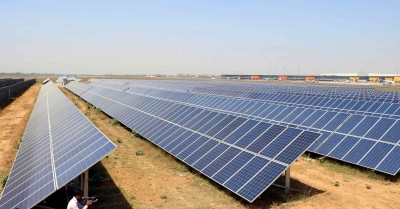India’s solar surge marks a bold leap towards a Net Zero future
By IANS | Updated: August 19, 2025 21:40 IST2025-08-19T21:31:13+5:302025-08-19T21:40:13+5:30
New Delhi, Aug 19 India has become the world’s 3rd-largest solar energy producer, doubled its solar manufacturing capacity ...

India’s solar surge marks a bold leap towards a Net Zero future
New Delhi, Aug 19 India has become the world’s 3rd-largest solar energy producer, doubled its solar manufacturing capacity and achieved its COP26 renewable energy target five years ahead of its Paris agreement goal, with renewables now powering over 50 per cent of the country’s total installed electricity generation capacity of 484.82 GW.
After crossing 100 GW of solar power, the country is on track to reach 500 GW of clean energy by 2030 and net-zero by 2070. Projects like large solar parks, rooftop solar, and the PM Surya Ghar Muft Bijli Yojana are helping households become self-reliant in energy.
India’s energy journey over the past decade reflects a strategic shift towards self-reliance, sustainability, and innovation. From green hydrogen to solar rooftops, rural electrification to digital procurement, every initiative underscores India’s vision of inclusive, secure, and clean energy for all. As the nation moves forward, its balanced and forward-looking energy strategy continues to power economic growth and a sustainable future.
India now ranks 4th globally in Renewable Energy Installed Capacity, 4th in Wind Power, and 3rd in Solar Power capacity. India’s solar module manufacturing capacity jumped from 38 GW to 74 GW during FY 2024-25.
Just a decade ago, India’s solar landscape was in its infancy, with panels dotting only a few rooftops and deserts. Today, the nation has raced ahead to script history: India has officially surpassed Japan to become the world’s third-largest solar power producer. According to the International Renewable Energy Agency (IRENA), India generated an impressive 1,08,494 GWh of solar energy, leaving Japan behind at 96,459 GWh.
India’s cumulative solar power capacity stood at 119.02 GW as of July 2025. This includes 90.99 GW from ground-mounted solar plants, 19.88 GW from grid-connected rooftop systems, 3.06 GW from hybrid projects, and 5.09 GW from off-grid solar installations, reflecting the country’s diverse approach to expanding renewable energy.
India’s progress in the renewable energy sector reflects the country's focused policies and strategic planning. Prime Minister Narendra Modi added momentum to the drive with his approach, highlighting that "Green Future, Net Zero aren't just fancy words but reflect India's need and commitment, making it the best destination for investment and innovation in renewable energy.”
India lies in the tropical region, with the Tropic of Cancer passing through many states. This gives the country a high potential for solar power generation. The total solar sector potential of the Indian continent is 748 GW. States and UTs like Rajasthan, Jammu and Kashmir, Maharashtra, Madhya Pradesh, and Andhra Pradesh have some of the highest solar potential in the country, making them key drivers of India's clean energy growth.
Region-wise, the major high-potential states include Northern and Western Rajasthan, Southern Gujarat, Central Karnataka, Tamil Nadu, Andhra Pradesh, Eastern and Other Maharashtra, Chhattisgarh, Odisha.
In July 2025, India’s solar power capacity had increased by 4,000 per cent, and the country’s total renewable energy capacity reached 227 GW. Palli village in Jammu and Kashmir became a notable example, emerging as India’s first carbon-neutral panchayat by running entirely on solar power. Emphasis was placed on the need for energy storage and the adoption of new technologies to meet future energy demands. Government schemes like the PM Surya Ghar Yojana and PM Kusum Yojana are playing a key role in helping households and farmers transition to clean solar energy.
India’s solar manufacturing sector includes key components like solar modules, solar PV cells, and ingots and wafers. Producing these within the country supports the domestic economy and reduces dependence on imports. In just one year, solar module manufacturing capacity nearly doubled—from 38 GW in March 2024 to 74 GW in March 2025. Similarly, solar PV cell manufacturing rose from 9 GW to 25 GW. A big milestone was the start of India’s first ingot-wafer manufacturing facility (2 GW), further strengthening the entire solar supply chain.
This rapid growth in domestic capacity is strongly supported by government policies. To promote Indian-made solar products, the government has made it mandatory for projects under schemes like the Rooftop Solar Programme, PM-KUSUM, and CPSU Scheme Phase II to use panels and cells made in India. To make this shift more effective, a Basic Customs Duty was introduced in April 2022 on imported solar cells and modules. This makes imports more expensive and encourages the use of Indian alternatives—boosting local manufacturing and reducing reliance on foreign suppliers.
Disclaimer: This post has been auto-published from an agency feed without any modifications to the text and has not been reviewed by an editor
Open in app